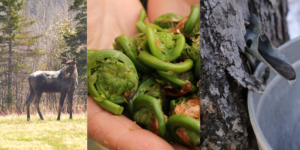
Elderberry Syrup is a great immune booster and it’s delicious too! A much more delightful tasting remedy than Fire Cider. It does not contain all the same benefits as Fire Cider, but it does have its place in my Apothecary cabinet.
Elderberries have been used for thousands of years. Hippocrates, the “Father of Modern Medicine” is said to have highly revered Elderberry’s healing abilities.
They come from the Sambucus shrub, showing off star-like blossoms in the Spring and lovely clusters of dark berries in the Summer. Elderberry thrives in zones 4-9
Elderberries are high in vitamin C, antioxidants and vitamin A. They also contain iron, folate, calcium and potassium.
This post contains affiliate links. Read full disclosure here.
The use of Elderberry Syrup dates back to at least the colonial days, probably even earlier. In this study Elderberry was shown to shorten the length of cold and flu-like symptoms by four days compared with those who did not take Elderberry.
It is important to note that raw elderberries, along with the leaves, roots and twigs of the bush are toxic. They contain a substance called glycoside, which causes the build up of cyanide in the body. Cooking the berries will deactivate the glycosides, making them perfectly safe to consume. Also, be sure to only pick the dark, ripe berries, not the red ones. Dried elderberries are not cooked and should never be eaten raw.
The blossoms are also edible and have medicinal properties too. They can treat conjunctivitis (commonly called “pinkeye”) and alleviate toothaches. Tea made from the blossoms is soothing, as elderflowers are a nervine, meaning they have a calming effect on your nervous system. The blossoms, like the berries can also relieve joint inflammation. They make an enjoyable tea and have a sweet, delicate aroma. To use the blossoms, pick them at full bloom. Check for any insects. Dry clusters of blossoms in a dark, dry place, such as a cabinet. Once completely dry (which could take a few weeks depending on your environment) be sure to pick the blossoms from the stems. Remember, the stems are not edible. Store your blossoms in a sealed container, such as a jar, and label with the date and perhaps even where you harvested them.
Let’s mak Elderberry Syrup!
You will need:
Dried Elderberries
Fresh Ginger
Pure Lemon Juice
Raw Honey
Ground Cinnamon or Cinnamon Sticks

Pick through your dried berries and pick out any stems or leaves. Peel and grate your ginger. Add your berries and ginger to a medium size dipper with water and simmer for 20-30 minutes, stirring frequently.

If using cinnamon sticks instead of ground cinnamon, add the sticks with the berries and ginger. When berries have softened, mash them in the dipper while they simmer. After 20-30 minutes strain and press out the berries and grated ginger. Pour the liquid back into the dipper. Once cooled to just warm, add the honey and stir until dissolved. Stir in the lemon juice and ground cinnamon. Then pour into a jar and label your syrup. This will keep for several weeks if you use a lot of honey. If you cut back on the honey it will not last as long because honey is a preservative, and on its own it never goes bad. If your syrup starts to smell fermented, it’s ok. Fermented is not bad, just not as flavorful, ha, ha.
To take elderberry syrup:
When ill take around 2-3 Tablespoons several times a day. Just to use as immune support take 1 Tablespoon once a day. Do not give to infants under 1 years old.
*Shop This Post*
Dried Elderberries
Raw Honey
Cinnamon Sticks
Yield: About 5 Cups
Elderberry Syrup

Elderberry Syrup is a great immune booster, cold and flu fighter, kid friendly and a must have in your medicine arsenal!
Prep Time
5 minutes
Cook Time
30 minutes
Total Time
35 minutes
Ingredients
- 4 Cups of Water
- 1.5 Cups dried Elderberries
- 3 Tablespoons freshly grated Ginger
- 1/2 Teaspoon of Cinnamon
- 1/4 Cup Lemon Juice
- 4 Cups Raw honey
Instructions
- Pick all twigs out of the dried elderberries. Place in a dipper, add water and grated ginger. If using cinnamon sticks, add them at this time. Simmer about 20-30 minutes, stirring frequently. As berries soften, mash them in the dipper while simmering.
- Strain the liquid through a fine strainer, pressing as much liquid as you can out of the cooked berries.
- Pour the juice back into the pot. Add the lemon juice and ground cinnamon if not using cinnamon sticks.
- When mixture has cooled to just warm, add honey and stir until completely dissolved.
- Keep in a jar in the refrigerator for several weeks or months depending on the amount of honey used. More honey makes it last longer, less honey causes it to ferment quicker.
- To use elderberry during illness, take 2-3 Tablespoons several times a day. 1-2 Tablespoons for small children. To support a healthy immune system, take 1 tablespoon once daily. May also be used on pancakes, etc. wherever you might use maple syrup as desired.
Notes
*Do not eat elderberries raw. Do not eat leaves, twigs or roots from elderberry shrub. They are toxic. Dried elderberries are raw and must be cooked.*



Leave a Reply
You must be logged in to post a comment.